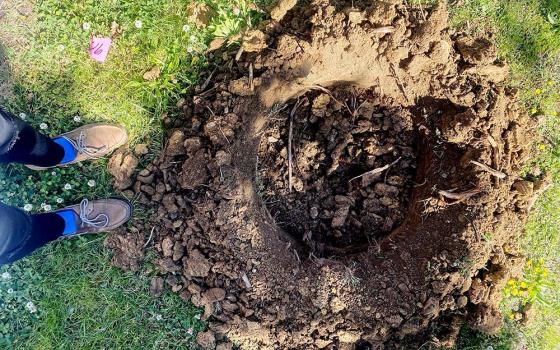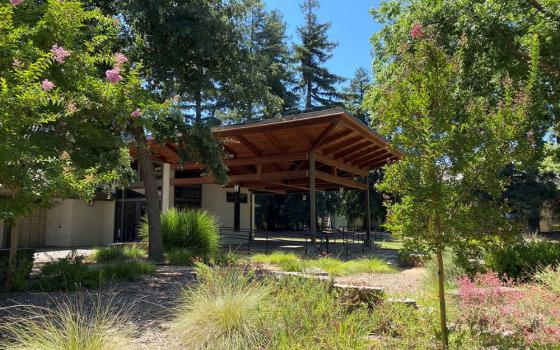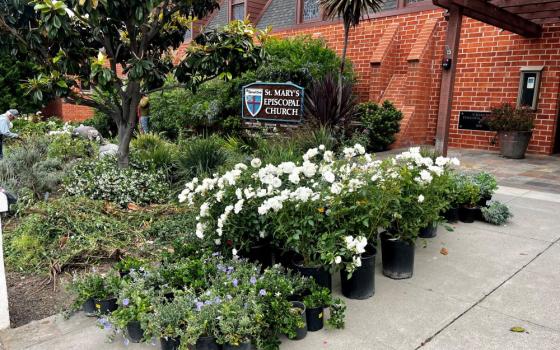
An energy audit allows church leaders to identify how much money various upgrades would cost and how much money and energy would be saved over each year from those upgrades.(Unsplash/Michał Turkiewicz)
Editor's note: This story, originally published by Sojourners, is part of "Growing a Green Church," an ongoing series focused on churches' efforts to steward their buildings and land effectively in the context of a changing climate. The project is produced in collaboration with The Christian Century, Episcopal News Service, Faithfully Magazine, National Catholic Reporter, and Sojourners, with support from the Solutions Journalism Network and funding from the Fetzer Institute. Find more stories in the series here.
Around 2017, Hamline Church United Methodist, in St. Paul, Minnesota, contracted an energy audit for its nearly 100-year-old building in the hopes of learning how their building might save energy and reduce emissions. Diane Krueger, a lay leader of the church's "EarthKeepers" team, said contractors recommended the church insulate their heating pipes and change many of their lightbulbs to LEDs.
She told Sojourners the audit allows church leaders to identify how much money various upgrades would cost and how much money and energy would be saved over each year from those upgrades.
Because every church is different, architects recommend churches looking to decrease energy usage start with an energy audit. During the audit, a consultant spends around half a day checking caulking and weather stripping, examining light fixtures, assessing water flow of appliances, and checking for leaks in both water systems and the air flow of a building. The consultant then writes up the audit, noting where the building is using electricity and why, as well as identifying leaks in the building.
Rick Archer, founding partner at Overland Partners Architecture + Urban Design, a globally recognized leader in sustainable design, said an energy audit could be a more effective way for churches to save energy, rather than installing new fixtures like low-flow toilets: "You'd be better off looking for water leaks in the system, which are probably consuming more water than flushing the toilet."
Advertisement
Heather Holdridge, sustainability director at Lake|Flato Architects in San Antonio, told Sojourners an energy audit can help a church create a plan for becoming more energy efficient.
"Whenever they create that predictive energy model, it actually gives you the ability to do a lot of if/then analysis," Holdridge said. "If they've modeled where every single one of [a church's] windows are located and what size they are, then you can start to model some different scenarios."
A church could compare the cost and energy saved in replacing windows, adding a film tint, or placing shade over the outside of the windows. "It enables you to very quickly iterate some different energy efficiency measures and see which ones have a reasonable payback," she said.
Krueger said the church recently completed another audit, which identified places that the church could install more LEDs that weren't able to be installed in 2017 and other upgrades they could make.
Archer said many municipalities provide free energy audits, while Holdridge said churches may have to hire a contractor.

According to a 2017 Baylor Religion Survey, 68% of U.S. Christians travel less than 15 minutes to church, and 21% travel less than 5 minutes from home to their place of worship. (Unsplash/Fredrik Solli Wandem)
Transit
While energy audits help churches increase their building's energy efficiency and cut emissions, churches could also help cut the greenhouse gases that congregants emit when traveling to church in the first place.
According to a 2017 Baylor Religion Survey, 68 percent of U.S. Christians travel less than 15 minutes to church, and 21 percent travel less than 5 minutes from home to their place of worship. The study found that congregants in rural areas were more likely than urban congregants to travel 5-16 minutes to church, and only slightly less likely to travel under 5 minutes.
Krueger said her church attempted a month dedicated to alternative transit methods a few years ago, with limited success. The church posted a map of the city, asking families to put pins in the map where they lived and if they were willing to carpool, but less than a dozen people participated. Krueger said a lack of promotion was probably what failed the project.
For churches looking to decrease transportation emissions, Holdridge suggests churches survey their congregants on distance and methods of transportation. In addition to helping map out potential carpools, churches could learn whether they have a need for more or better bike racks.
As director and founder of the Proximity Project, Sara Joy Proppe spent the past several years working to help churches consider how land use might be part of their mission to serve their community. While churches can get cheap bike racks from Amazon or other major retailers, Proppe said these can be so inefficient or unusable as to be useless. While getting a quality bike rack is the first step, churches need to consider location as well.
"If you put the rack next to the wall, you can't even fit your bike," Proppe said. Many bike rack companies include guides to installation, including methods and dimensions needed for each rack, she said.
For churches looking to install bike racks for the first time, Holdridge recommends assessing what needs the bike racks will fill. If racks are intended to provide safekeeping for cyclists during worship hours on Sunday, a simple metal rack may do. But if daily staff at the church are hoping to reduce their emissions by biking to work each day, Holdridge recommended considering bike lockers that can better protect from weather and theft.
Proppe has led workshops and longer-term projects for churches trying to increase their openness to non-car transportation. When trying to encourage congregants to bike or transit to church, she's found the biggest hurdle is uncertainty about bike and bus routes among congregants who typically drive. One simple tip she recommends is that every church provide bike and bus routes on their website, as opposed to only including driving directions.
"The more that you can facilitate a safe environment for them to experience and to learn [biking], the more confidence that's going to give them to be able to bike to church and do those things on their own," Proppe said.
In addition to the reduced greenhouse emissions, Proppe said these projects can help churches understand and address social and class inequities.
"When you're on the bus and you're recognizing the frustrations, honestly, that public transit can produce … you have a much more empathetic heart for the people who are limited to public transit as their form of transportation," Proppe said.

Churches can consider re-landscaping to plant native species on their property. Native species better suit the local ecosystem, but they can also help reduce water usage and maintenance. (Unsplash/Annie Spratt)
Gardens, parking, outdoor spaces
Archer said that some older churches weren't landscaped with droughts in mind, and recommends churches consider re-landscaping to plant native species on their property. Native species better suit the local ecosystem, but they can also help reduce water usage and maintenance.
"[By] swapping out for native species or drought-tolerant species, or reducing the amount of lawn, you can reduce maintenance costs, which then reduces the consumption of fossil fuels in maintaining them," Archer said. "It also helps air quality because you're not releasing carbon into the air when you maintain a landscape because you reduce the amount of maintenance that it requires."
At Hamline, Krueger said the church eliminated about a quarter of its parking lot, turning it into a greenway of benches and native plants. By installing the greenway in place of a parking lot, the church reduced the "heat island effect," which the Environmental Protection Agency says can cause daytime temperatures to be 1-7 degrees higher in the daytime and 2-5 degrees higher at night.
"Churches ought to do a study of how much of the parking they're actually using," Archer said. "There's always an assumption that we don't have enough parking. But the reality is I'm not sure that's always true."
And for the parking spaces churches do need, Archer suggested considering local partnerships with electricity companies. Archer mentioned Community Solar, a San Antonio company that leases parking lots and builds solar-panel shade coverings; the coverings provide a triple benefit in that they create shade, clean energy, and potentially a financial benefit for the congregation.
Getting the most out of buildings
Archer and Holdridge said the most energy efficient method for churches might not be reducing their usage but increasing it.
According to Architecture 2030, a climate-focused nonprofit, 13 percent of all greenhouse gas emissions come from building and infrastructure materials and construction.
"Concrete and steel are very carbon intensive; the process for manufacturing them causes a lot of greenhouse gas emissions," Holdridge said. The industry maxim, "the greenest building is the one already built," means churches should be looking for ways to renovate, restore, and prolong building use.
Archer suggested the biggest climate impact might be a church that allows its space to be used by the community outside of worship times, thereby cutting down the need for new buildings and community centers.
"For many churches, [their] buildings … may be used on Sunday morning for a few hours, then they sit relatively empty the rest of the week," Archer said. "That's just poor stewardship."
Energy use
Holdridge said that, as important as energy-friendly buildings and systems are, there is a saying in her industry that "there are no net zero buildings without net zero occupants."
To get congregants to think more about their energy use, simple posted reminders to turn off lights or reduce water use can be effective, as can an "energy dashboard" that provides real time feedback on how much energy is being used in the building.
"Simply putting that information on display and making it publicly accessible is a really effective way to actually empower people to feel like their actions matter," she said. While dashboards are most common in universities, Holdridge said the effects could be increased in churches where building users are consistent across years.
Krueger said Hamline monitors their energy using an Energy Star Portfolio Manager, which helped them track initial savings when switching to LED lightbulbs. The manager also helps them track when energy is used across the year, like during cold Minnesota winters.






